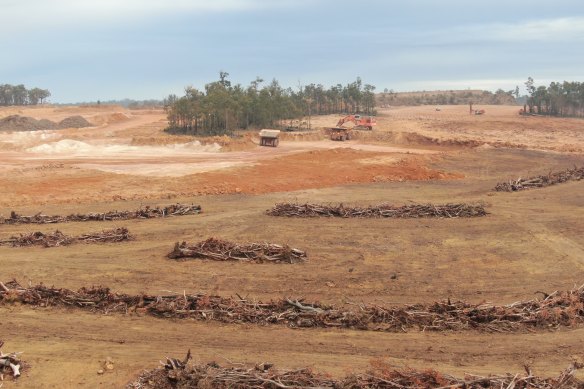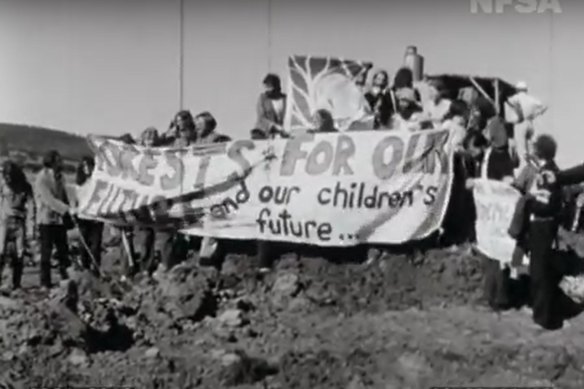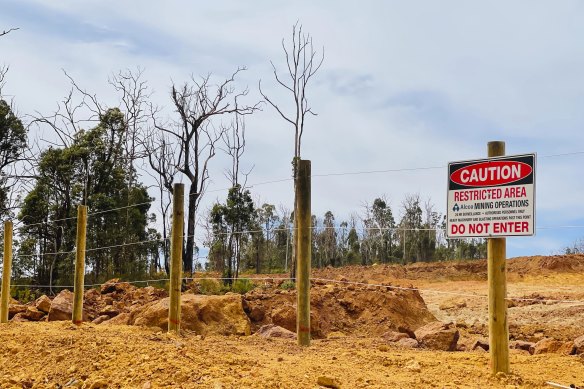This was published 8 months ago
World-first test gives Alcoa two stars for Australian environmental performance
By Emma Young
The first independent non-governmental assessment of Alcoa’s impact on Western Australia’s landscape over the past 60 years baldly states that the US mining giant has not rehabilitated the state’s jarrah forests and will not be able to.
The peer-reviewed paper is the result of two years’ work by an international authorship team, published this week in the journal Restoration Ecology, and is the first to assess Alcoa’s performance against international mining rehabilitation standards, giving Alcoa two of a potential five stars for its attempts to restore the forests of state’s south-west.

The emus only just visible in the foreground of this picture of Alcoa’s operations highlight the large area required for strip-mining – a process that removes all biological material from the site to access the flat rock layers beneath.
Alcoa’s WA operation is the world’s third largest mine overall and the largest in any of the 36 global biodiversity hotspots, says the paper, which is the first to assess any project worldwide against the 2022-completed international standard, and incorporates the work of one of the standards’ lead authors, noted US ecologist George Gann.
The study concludes that the WA jarrah forest – the world’s most biodiverse temperate forest – is an ancient ecosystem that evolved over millions of years, and since the best and most diverse forest develops on the best bauxite, the total loss of this ancient rock substrate leaves the rehabilitation in a high-risk situation – particularly at a time of climate change.
“Alcoa have spent 60 years of operation trying to come up with rehabilitation that works,” said study lead Professor Kingsley Dixon.
“They’ve spent more than any other global mining company on trying to find environmental solutions to the forest clearing.
“The scientific community is clear: it is not a lack of knowledge but a lack of the ecological fabric to create a jarrah forest that is the issue.”
Alcoa publicly states its goal is “restoring healthy, resilient forest ecosystems” with a trajectory that will eventually approximate the richness and functionality of virgin forest. If looked at in terms of the new international standard, this would be a four-star and eventually a five-star outcome.
The paper has judged Alcoa to have achieved an average of two stars over its 60 years of mining in WA.
It has cleared 28,000 hectares between the semi-rural outer Perth suburb of Mundaring and the south-west regional town of Collie and impacted 91,000 in total, with the state estimating Alcoa is clearing 800 hectares annually, and currently planning major expansions.
In this operation to date, Alcoa has directly impacted at least 400 plant species of the 800-plus in its lease area.

A 1979 protest against Alcoa’s operation in Wagerup. Credit: NFSA
The paper found that in rehabilitated areas, weeds were widespread and 25 times more common than in native forest; grass trees and mature trees were missing; native grasses absent or virtually so; and places for creatures to live such as logs and woody debris were more than 100 times lower.
Two-thirds of “indicator plants” were significantly under-represented in Alcoa’s early-stage restoration efforts.
Alcoa translocated no wildlife from the cleared areas, and recovery of wildlife into rehabilitated areas was poor for entire groups of fauna with little evidence of animals re-occupying long-term.
The study noted that time required for trees to mature prevented the production of fundamental habitat features such as hollows and logs, for well over a century – preventing the return of species including endangered black cockatoos.
The paper says that previous assessments were wrong in assuming that early success assured eventual full restoration.
It found initial species richness did not reflect future quality and rehabilitated areas tended to get worse, not better, with time.
“We found a worryingly large drop-out of species over time, which was what prompted this more intensive investigation using the standards,” Dixon said.
“Given the evidence to date, and consistent with the standards, the promise of ecological restoration should not be used to justify the continued destruction of this globally significant biodiverse ecosystem,” the paper concluded.
“Rather, additional impacts to intact jarrah forests should be avoided … until when and if successful long-term and resilient restoration outcomes are proven.”

Alcoa has cleared extensive areas of forest for its Willowdale bauxite mine.Credit: Jess Beckerling
Alcoa’s proposed expansion could impact an estimated up to 1400 species, with more than 40 rare species having a “moderate to high likelihood” of living in the proposed areas, the paper says.
Its mineral lease (separate from environmental conditions) was renewed last month, for a period of 21 years.
A spokesman for Alcoa said the company recognised and respected the work done by the global Society for Ecological Restoration, which produced the international standard – one of the tools Alcoa used to inform its restoration work.
He said Alcoa had made a significant contribution to the science informing mining restorations, including the work of the society.
With external input, Alcoa had done its own evaluation of its rehabilitation using the international standards and recorded an average of four out of five stars.
This result was consistent, he said, with a 2023 independent peer review which concluded that Alcoa’s rehabilitation practices in WA and its related research remained “as sophisticated and comprehensive as for any mining operations globally”.
The spokesman said Alcoa’s WA works were formally measured against state government criteria set specifically for this operation in this area.
He said Alcoa was not aware of any scientific evidence that the jarrah forest could not be restored on areas mined for bauxite.
“While we acknowledge that some elements of the restored forest will take many years to develop, we are confident our practices are successfully re-establishing a healthy jarrah forest ecosystem,” he said.
“That includes the return of native fauna with peer-reviewed research identifying that 100 per cent of mammals and around 90 per cent of birds and reptiles have returned to restored areas of around 20 years of age. We continue to invest in the science to understand forest health and management, including addressing factors such as the drying climate.
“We recently announced an allocation of $15 million to forest research over the next five years and expansion of our environmental research team.”
Start the day with a summary of the day’s most important and interesting stories, analysis and insights. Sign up for our Morning Edition newsletter.